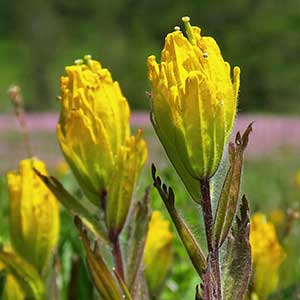Castilleja levisecta
Castilleja uliginosa
golden Indian paintbrush, golden paintbrush
Pitkin Marsh Indian paintbrush, Pitkin Marsh paintbrush
few to many, erect, ± decumbent or creeping at base, unbranched, sometimes branched, hairs spreading, medium length and long, soft, mixed with short stipitate-glandular ones.
several, decumbent proximally and sometimes becoming weakly rhizomatous, becoming ascending to erect, unbranched or often branched proximally, hairs spreading, short and long, soft, mixed eglandular and stipitate-glandular.
green to purple or brown-tinged, linear-lanceolate proximally, oblong-ovate or -obovate distally, 0.8–5.2 cm, not fleshy, margins plane, distalmost sometimes ± wavy, involute, 3–7(–11)-lobed, apex obtuse;
lobes erect to ascending, linear to linear-spatulate, very short, toothlike, usually arising from distal 1/3 of blade, apex rounded.
green, lanceolate or broadly lanceolate, 3–5 cm, much reduced distally, not fleshy, margins plane, sometimes ± wavy, flat, 0-lobed, apex acute to rounded.
2.5–25 × 1–4 cm;
bracts bright yellow throughout, or proximally greenish, distally bright yellow, sometimes deep yellow-orange, especially with age, oblong, elliptic, or obtuse to ovate, (0–)5–9(–13)-lobed, sometimes wavy-margined;
lobes erect to ascending, oblong, short to medium length, arising above mid length, central lobe apex rounded, lateral ones rounded to acute.
10–30 × 3–4 cm;
bracts pale yellow to cream throughout, or proximally pale greenish near base, distally pale yellow to cream, broadly lanceolate, 3-lobed;
lobes ascending, narrowly lanceolate, long, arising near mid length, apex narrowly acute or acuminate.
straight or slightly curved, 17–28 mm;
tube 12–15 mm;
beak exserted, adaxially green or greenish yellow, 6–8 mm;
abaxial lip yellow or greenish, reduced, not inflated, 2–3 mm, 25–33(–50)% as long as beak;
teeth ascending to erect, yellow, 0.5–1.5 mm.
slightly curved, 22–30 mm;
tube 11–15 mm;
beak partly exserted, adaxially whitish, yellowish, or greenish, 10–15 mm;
abaxial lip green, small, protuberant, 3 mm, ca. 20% as long as beak;
teeth erect to incurved, green, to 1 mm.
distally yellow, 13–22 mm;
abaxial and adaxial clefts 4–9.5 mm, 30–40% of calyx length, deeper than laterals, lateral 2.5–4.5 mm, ca. 25% of calyx length;
lobes linear to narrowly oblong or narrowly lanceolate, apex obtuse, sometimes rounded to acute.
colored as bracts, 20–25 mm;
abaxial and adaxial clefts 7–14 mm, ca. 50% of calyx length, deeper than laterals, lateral 5–6 mm, ca. 33% of calyx length;
lobes linear, apex acute, ciliate.
= 24.
Castilleja levisecta
Castilleja uliginosa
Castilleja levisecta is listed as threatened in the United States and endangered in Canada, where it is extremely rare. Most of its grassland habitat has been altered by development in the Puget Trough, and there are historical stations in the metro areas of what are now Victoria, Portland, and Seattle. For several decades, C. levisecta was considered extirpated from Oregon. However, recent reintroduction programs in Oregon and Washington have been very successful at reestablishing this species at several sites in the Willamette Valley. The bright yellow inflorescences often gradually age to a golden yellow color, unique in the genus.
Castilleja levisecta is in the Center for Plant Conservation’s National Collection of Endangered Plants.
(Discussion copyrighted by Flora of North America; reprinted with permission.)
Castilleja uliginosa is endemic to Pitkin Marsh in Sonoma County. It differs from C. miniata by its uniformly pale yellow inflorescences and pubescent stems, as well as by its disjunct, low-elevation habitat. Much of its available habitat was destroyed by development, and it is apparently now extirpated from the wild. It survives in the form of tissue clones from the last wild plant, backcrossed with C. miniata by L. R. Heckard in the 1980s and maintained since then in the greenhouses at the University of California at Berkeley.
(Discussion copyrighted by Flora of North America; reprinted with permission.)


